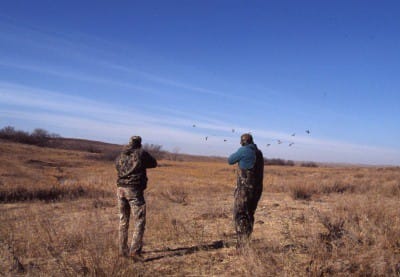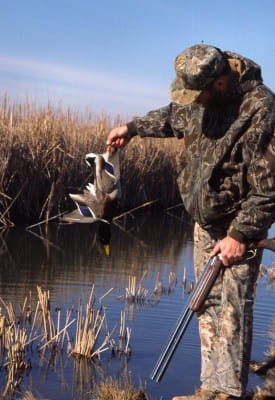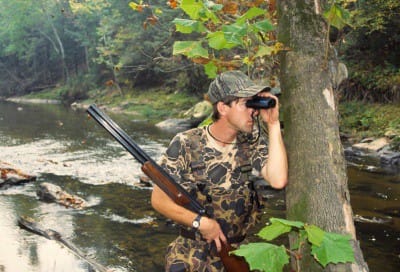
Bluebird days can spell disaster for even the best-planned duck hunt. After a brief flurry of early-morning activity, the birds settle in to marshes, ponds and rivers and they don’t move until after legal shooting time. So what do you do?
The obvious answer, of course, is to go to the ducks. Jump shooting—stalking within shotgun range of a flock of resting birds—is not only an exciting way to test your hunting skills, it’s the perfect method for filling out a limit when the ducks aren’t flying. It’s also a great way to pass the hours between the morning flight and the evening flight.
“Several of the farms I hunt in western Maryland have ponds on them, and the farms on the Eastern Shore have ponds and creeks that are perfect for jump-shooting,” said Mark Hoke, a pro-staffer for Avery Outdoors. “If the ducks aren’t flying, my friends and I will try to sneak into range and jump-shoot them.”

Hoke said sneaking up on a flock of ducks can be as challenging as trying to stalk within rifle range of any big game animal. In the right situation, however, it can be a slam-dunk.
“I look for thick brush, a hill or some other feature that will help me stay hidden from the birds as I move in on them,” he explained. “I may have to belly-crawl, or at least crawl on my hands and knees, but I’ll do whatever it takes to stay out of sight.”
Before he makes a move, Hoke will first get a bearing on the location of the birds from a distance, and typically studies the ducks, the water itself and any obvious landmarks that will help him move to the perfect spot. Once he starts his stalk, Hoke stays down and doesn’t poke his head up to check on the birds. Do that and you’ll probably get busted and blow the stalk before you get into range. In some cases, Hoke will wear an orange hat or at least tuck one into his back pocket as a safety precaution, something that gives him peace of mind as he’s crawling through thick brush.
“I feel perfectly safe without it, but it doesn’t hurt to take any precautions you can,” he said. “As long as you stay out of sight, it won’t spook the ducks.”
Team Tactics
In some instances, sneaking up on a flock of loafing ducks just isn’t an option, at least not by yourself. The birds are either sitting in the middle of the pond out of shooting range, or they are loafing on the edge of an open bank with no cover to help you stalk within range. That’s when a friend or two can come in handy. Hoke and his partners will study the birds and the terrain and try to figure out where the ducks will fly when they are spooked off the water. It’s hardly an exact science, he admitted, but he said it can be a rewarding way to bag a few birds if everything works as planned.

“If the ducks are sitting on a pond with a dam, I’ll put one guy on either corner of the dam and move around to the upper end of the pond to try to get the ducks to fly over the dam,” explained Hoke. “You have to come at the birds from an angle that will push them in the direction of the guys waiting. If there is no dam, you just have to find a low spot in some trees or a ditch that you can hide in and hope the birds fly over the shooters.”
He’s used that trick on smaller rivers, where ducks will often fly right up the water to waiting guns. Hoke simply drops off a buddy up a small river or creek and he’ll circle back below the birds and flush them off the water. It’s a slam-dunk for wood ducks on smaller rivers, he said, and it’s a trick he’s used successfully for years.
Jump-shooting doesn’t always work, but it sure beats sitting in a blind and staring at empty skies.



